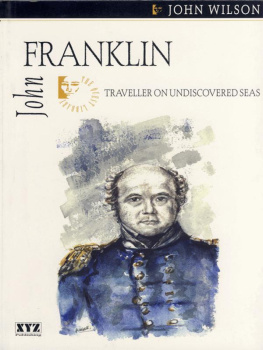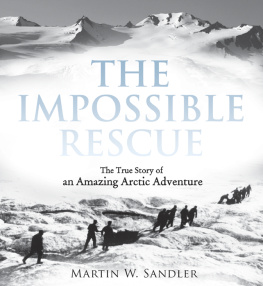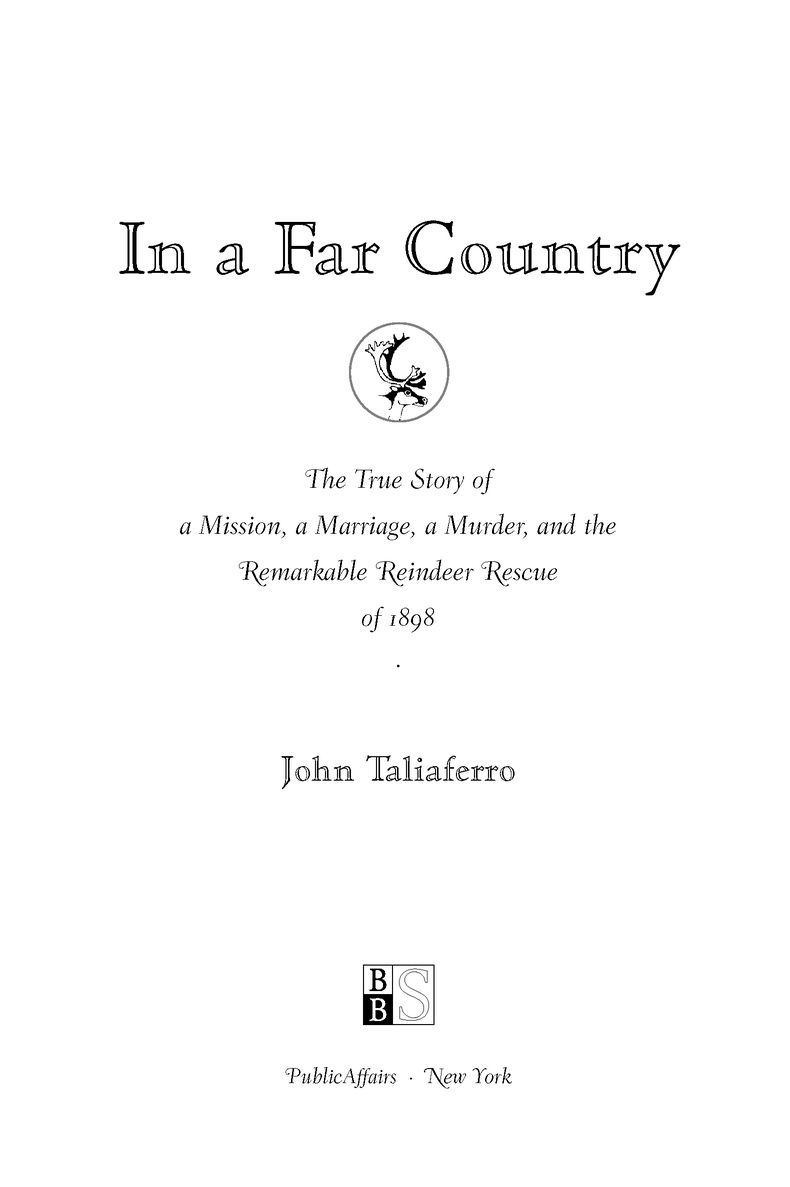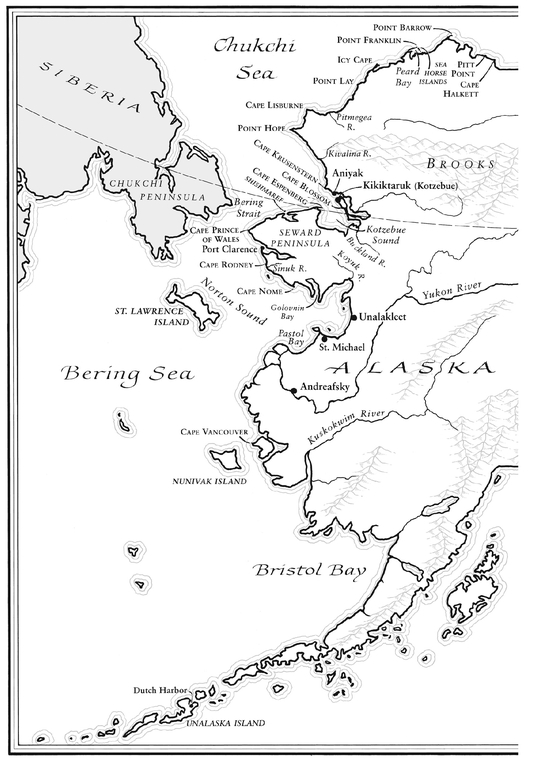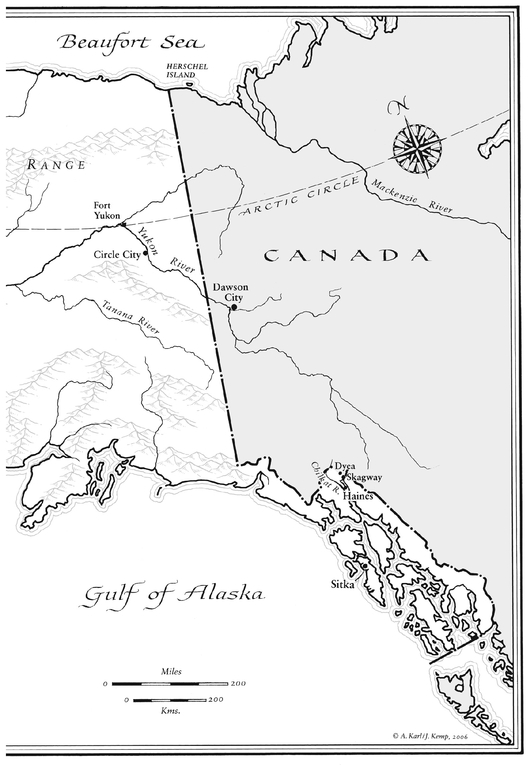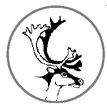Table of Contents
Praise for In a Far Country
A rollicking Jack London-style tale (though more understated) with a story of love and commitment at its center.
San Antonio Express-News
In 1898, [Tom] Lopp was called upon to lead a winter-relief expedition 700 miles north to Barrow, to bring reindeer to feed 200 whalers whose ships had become trapped in the ice. Although Taliaferro uses this exciting tale to frame his book, its only part of the story. [W]e catch glimpses of the Alaskan frontier at a time of enormous change.
Seattle Times
Here is the perfect Arctic adventuresmart, exciting, and all true. A hard one to put down. If you want more ice cold courage and endurance on land and sea than John Taliaferro has woven out of history, youre not getting enough frostbite lately.
SETH KANTNER, author of the national
bestseller, Ordinary Wolves
Rich in detailathorough account of a long-forgotten adventure.
Booklist
It is hard to believe that the epic adventures of Tom and Ellen Lopp have remained largely undiscovered until now. In a Far Country is a gripping and inspiring true story that combines all the best elements of a touching love poem, a deep and resounding history lesson, and a pulse-quickening action-adventure tale. John Taliaferros research is impressive and thorough, and his writing is crisp and vivid. He does not impose himself on the story, but rather lets his remarkable characters and their actions breathe and live on the page. Riveting.
JENNIFER NIVEN, author of The Ice Master and Ada Blackjack
[Taliaferros] well-written account focuses on the trials and triumphs of the Lopps, their family life, and their American Missionary Association work in frontier Alaska prior to and immediately after the rescue expedition. [A] vivid, thoughtful, and often heartbreaking portrait of a brutal yet fragile wilderness, threatened by the destabilizing encroachment of modernity into native communities.
Library Journal
ALSO BY JOHN TALIAFERRO
Charles M. Russell:
The Life and Legend of Americas Cowboy Artist
Tarzan Forever:
The Life of Edgar Rice Burroughs, Creator of Tarzan
Great White Fathers:
The Story of the Obsessive Quest to Create Mount Rushmore
For Jane
The man who turns his back upon the comforts of an elder civilization, to face the savage youth, the primordial simplicity of the North, may estimate success at an inverse ratio to the quantity and quality of his hopelessly fixed habits. He will soon discover, if he be a fit candidate, that the material habits are the less important. The exchange of such things as a dainty menu for rough fare, of the stiff leather shoe for the soft, shapeless moccasin, of the feather bed for a couch in the snow, is after all a very easy matter. But his pinch will come in learning properly to shape his minds attitude toward all things, and especially toward his fellow man. For the courtesies of ordinary life, he must substitute unselfishness, forbearance, and tolerance. Thus, and thus only, can he gain that pearl of great price,true comradeship. He must not say Thank you; he must mean it without opening his mouth, and prove it by responding in kind. In short, he must substitute the deed for the word, the spirit for the letter.
JACK LONDON, IN A FAR COUNTRY (1899)
Introduction
TOM AND ELLEN LOPP had long since accustomed the natives to knock before entering. Yet the rap on the outer door was decidedly sharper than the polite thump that they might expect from one of the villagers. On the twenty-fourth of January, with the temperature at thirty below, an Eskimo would have kept his mitten on, softening the blow. This sound was more imperative, more official, definitely not Eskimo.
The Lopps had not seen another white man since September, when the revenue cutter had dropped anchor briefly at the end of its annual Arctic patrol and put a boat ashore to share news and collect mail. In previous years, the Lopps would have caught sight of a dozen or more ships passing through the Bering Strait, bound for San Francisco from the whaling grounds of the Beaufort and Chukchi seas. At Cape Prince of Wales, where the Lopps lived, the strait is at its most narrow, the Russian shore only fifty-five miles away. On clear days, the headlands of East Cape, Siberia, are a sturdy seam stitched across the western horizon.
This past fall, however, the Lopps had observed no sails or plumes of coal smoke, and they had noticed only one set of lights in the boreal darkness. So perhaps some were frozen or wrecked up north, Ellen Lopp wrote to her family in Minnesota, accepting that her letter would not reach them until the following year. By now the sea was choked with ice, and any ships still in Arctic waters would be icebound or worse. This time of year even the overland link between the Cape and the nearest white outpost, the government reindeer station and Lutheran mission at Port Clarence, sixty miles around the coastline of Seward Peninsula, was treacherous and reluctantly traveled. The stranger at the door, then, was in dire need, on critical business, or both.
He certainly looked Eskimo. He wore a deerskin atigi trimmed with wolf fur and deerskin boots soled with the tough hide of bearded seal. The only anomaly was a woolen scarf to protect cheeks livid from harsh winter travel. Not until he gave his name did Tom Lopp recognize him. He was Lieutenant David H. Jarvis, second in command of the U.S. Revenue Cutter Services Bear, the ship that had called at Cape Prince of Wales four months earlier and on numerous occasions before then. Almost as surprising as the presence of Jarvis was that of a second man, Charlie Antisarlook, an Eskimo whom Lopp knew better than he did the Revenue Cutter Service officer. Lopp had befriended Antisarlook not long after coming to the Cape, eight years earlier, and Lopp had been instrumental in persuading the government to entrust Antisarlook with his own herd of reindeer, which now grazed a hundred miles to the south, on Norton Sound. Lopp was certain that Antisarlook would not have traveled so far from his home on a whim. Nor, he suspected, could Jarvis have made it this far without Antisarlook. As Lopp sized up his two trail-stiff visitors, dozens of Cape villagers approached across the packed snow, inquisitive about the unexpected outsiders.
Never one to be thrown off balance for long, Lopp invited the two men indoors to warm and explain themselves. The Lopp house was far from roomy, barely big enough for the family, even less so since the birth of a fourth child in October. Lopp had built it himself. Lumberanything milled, forged, or manufacturedhad to come by ship from Outsidemore than two thousand miles to the south and reachable only three or four months of the year. For those living seventy miles below the Arctic Circle, the only available building materials were earth, animal skin, snow, icenatives were masters of all of theseor Lopps choice, driftwood logs, flung seaward by Alaskas muscular rivers and washed up on beaches many hundreds of miles from their origin. (While natives from Greenland to Siberiaknown variously as Inuit, Inupiat, Yupik, and in Alaska also by the catch-all, Eskimoesteemed wood as a source of fuel, shelter, sleds, and boats, few of the Arctics indigenous people had ever laid eyes on a living tree of any stature.)







